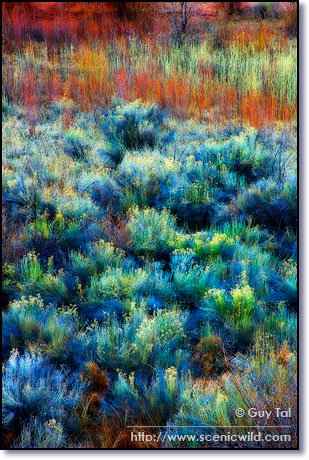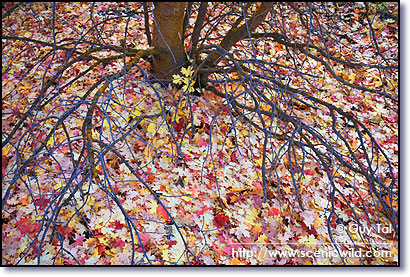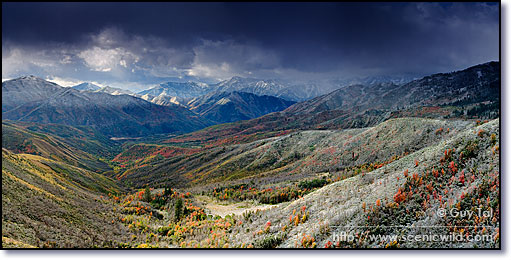The Essential Landscape
Common Sense and Common Sins in Nature Photography - Part II
Text and photography copyright © Guy Tal. All rights reserved.
In my previous installment, I discussed some perceived-truths and misconceptions in nature photography. This month I'd like to round up the list with a few more, primarily in an attempt to stimulate some creative thinking. And, as before, let's start with the words of a dead philosopher - Danish theater-fan Soren Kierkegaard - who said: "To dare is to lose one's footing momentarily. Not to dare is to lose oneself." Dare to be creative!
Sharpness Doesn't Always Matter

In the pursuit of technical perfection, many of us become obsessed with sharpness. We use sharpness as the ultimate measure for the quality of lenses and prints. We haul back-breaking loads of fast/heavy lenses and heavy cameras just to squeeze every last detail from a scene so that we can later render it with all its intricacies and crisp splendor on a large piece of paper. Sharpness is, in short, the one quality by which all technical aspects of an image are measured. It is easy to see why achieving ultimate sharpness has become the panacea for many photographers. While justified to a large extent, such an approach will often make one miss some creative opportunities.
In fact, there are many situations in which sharp detail can be a distraction and where creative blur can actually enhance the visual appeal of an image. Examples can often be found in portrait work, and in macro and wildlife images, where blurring of the background serves to help the main subject stand out. A somewhat different scenario along the same lines may apply in landscape images where eliminating detail helps emphasize form, color, and other more graphic elements of the scene.
Striving for technical perfection is admirable and should by all means be a goal, but be careful not to let it blind you to the fact that expressive images live or die by their emotional appeal first, and technical aspects second.
An Image in the Files is better than a Zeiss in the Bag
Equipment snobbery is part and parcel of a craft so dependent on technical excellence. Who among us doesn't yearn for this exotic piece of glass, that expensive gadget, or the other thing, you know, the one with the red stripe or the impressive logo or the fancy acronym engraved in gold letters.
It still makes sense to step back for a reality check every now and then, and face the facts before allowing such gear lust to drive one into bankruptcy. When it comes down to it - a good image is a good image, and while an expensive lens may have made it a bit sharper the reality is most viewers would never know the difference.
In these cases it is worth remembering the law of diminishing returns. Up to a certain point, better gear will produce visibly better results, but beyond that any increment becomes smaller and less significant while the cost grows disproportionally. Differences in specifications or lab measurements do not readily transform into "better" images. An emotionally moving, well-composed, beautifully-lit image captured with a consumer-grade zoom lens will still beat an uninspired, technically-perfect one made with an exotic prime any day.
I have yet to hear "wow, look at that MTF!" from anyone visiting an exhibit.
Originality is a By-Product, not a Goal
What exactly does it mean to be original? Is it all about creating something different from anything that's been done before? Are we not all sufficiently different people that we are each original by design? In that context lack of originality really boils down to not deliberately trying to mimic others. This is a very different approach from striving to make one's work different for the sake of originality.
Taken a step further, is producing original work inherently good? Is the fact that something has never been done before sufficient to elevate its worth, regardless of other appeal it may or may not possess?
All too often I hear of photographers promoting a given work in terms of "nobody photographed it from this angle before." Is it perhaps possible that nobody has done it because this angle is simply not a very flattering one?

Not to be misunderstood, I admire and seek and thrive on original work. I just don't think it's as easy as trying a new angle or a different lens or picking a filter from the Photoshop menu. Original work to me is one that tells me something about the subject I had not known or did not realize before and, just as important, does so in conjunction with everything else that makes an image appealing. In other words - if the image doesn't inspire me emotionally, if the composition feels awkward or absent, if the light is not quite right - does it really matter how original it is?
Mimicry is not to be undervalued either. It plays a big part in how we learn, how we set goals for ourselves, how we come to realize what inspires and moves us, and ultimately - how we define ourselves relative to others. I wholeheartedly encourage anyone to aspire to make images like those that moved them. This, however, does not mean one should set out to duplicate a work made by another as their ultimate goal.
Simply put, originality is already in you. All you need to do is to embrace those things that make you unique, to allow yourself the freedom to explore and portray the things that move you, beyond the things done by others and without forcing yourself to find something - anything - that had not been done before for the sole purpose of being original. Free your mind, and originality will follow.
Don't Capture, Don't Shoot, Don't Snap - Create, Produce, Orchestrate, Arrange
In other words - put some of yourself into the image. Yes, we're down to semantics here, but if you believe linguistics heavyweight Noam Chomsky, "even the interpretation and use of words involves a process of free creation."
There is a vast difference between setting out to "shoot" a given subject vs. venturing to create a meaningful image of it. By definition meaning implies a conscious process of understanding, of interpretation, of seeking or expressing knowledge. Without sounding too "New Age" I can tell you that conditioning your brain to think in these terms can indeed make a meaningful difference in how and what you see as you approach a scene.
Further, the subject itself may not always produce the most meaningful image. Think in terms of composition and context: what can I do with the materials available to me? What order, arrangement, or relationship can I create that would be meaningful?
All Photography is Autobiographical
Yes, I borrowed this last title from the great director Federico Fellini who said that "all art is autobiographical." This is not so much a mis-perceived truth as it is one that most are not consciously aware of. Your work is your legacy. These images that you create as you wander through life will tell others that you once walked the Earth and that these things inspired you. How would you want to be remembered?
More than just your technical skill is at stake here. Ask yourself what one might learn about you from seeing your work. What are the things that stopped you in your tracks and inspired you to make an image? Where have you been, and what did it look like (to you), way back then? What are the things you tried to convey to those who view your images? to loved ones? to complete strangers?

Don't dismiss your involvement in your own art to being just a bystander who knows how to operate a camera. Make it count! Make it count as one of yours!
GT-NPN 0440
Comments on NPN landscape photography articles? Send them to the editor.
Guy Tal resides in Utah, where most of the Colorado Plateau's breathtaking grandeur can be found, and where issues of preservation and land-use are among the most prominent on the political agenda. Guy's photography and writing can be viewed on his website at http://scenicwild.com.


| 


